The 6 Most Scenic Train Routes in North America
12 min readIn my early 20s, I zigzagged across Europe by train. Fresh out of college and pinching pennies on a month-long backpacking trip in Italy and Switzerland, I went by overnight rail, combining the cost of a room with travel to wake up in a new country each morning. It was amazing.
Traveling long distance by train is on the rise again, as adventurers look for an eco-friendly and engaging alternative to flying. In Western Europe, night trains are seeing a post-Covid resurgence, with the new Nightjet network connecting major cities. Here in the United States, Amtrak has purchased 125 new diesel-electric locomotives, most for long-distance use. In the past several years, the company spent $580 million in station upgrades and put $28 million toward upgrading its overnight railcars’ seating, lighting, tables, and bedding, as well as reintroducing dining cars after a pandemic-forced hiatus.
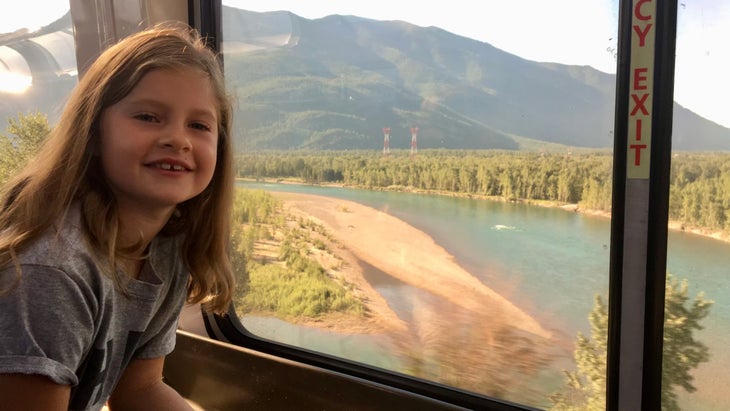
Going by train isn’t about getting somewhere fast, or cheaply either: Amtrak and other operators in the U.S. and Canada can’t compete with the budget airlines. But train travel is more eco-friendly than flying, especially with the new diesel-electric locomotives. Trains, writes Andres Eskenazi of the Kleinman Center for Energy Policy, “pollute much less than airplanes, sometimes by as much as 73 percent, and they are more easily electrified than planes.”
You can customize a train trip with layover days in any stop along the route, to explore an interim park or town. (Arrange the stops upfront when you book.)
Traveling by train is fun and relaxing; you can read a book, stare out the window, walk around, play cards, or see a film. Just ask Hartwell Carson, who has ridden the rails with his daughter, 13-year-old Evan, multiple times since she was eight.
“It’s everything that is great about traveling,” Carson says. “You’re forced to slow down and spend quality time with your companions. My daughter and I read books, drew pictures, and went to the dining car. There is nowhere to go, so you slowly watch the landscape change. It takes you back to a time when the journey was as important as the destination.”
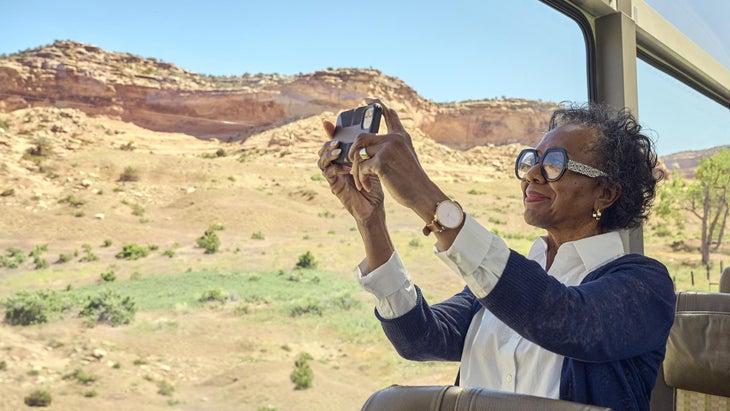
We’re all about that. So here are six of the most scenic rail journeys in North America, and great things to do along the way, including in our national parks. (Note that costs given are for one-way trips.)
1. The Vermonter
The Route: Washington, D.C., to St. Albans, Vermont
Duration: 611 miles, 13 hours
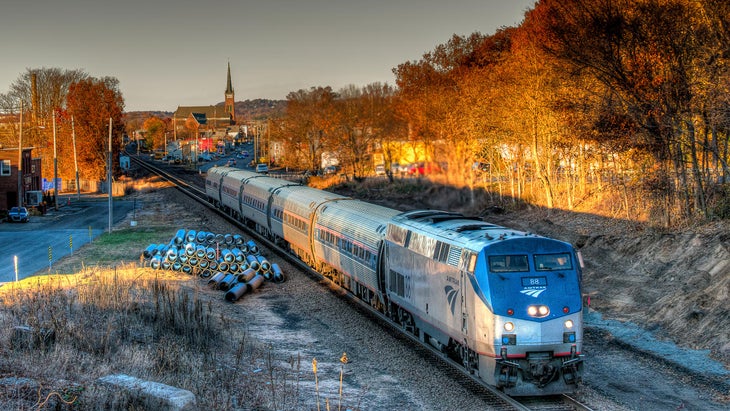
Want variety? How about a train that travels through nine states, some of the largest cities in the country, lush farming valleys, and rugged mountains? The Vermonter connects Washington, D.C., with the villages of Vermont right up to the Canadian border, and stops in Philadelphia and New York City along the way. The trip begins among towering skyscrapers, but once you pass New York City, you hit the estuary of Long Island Sound, with its islands and tall seagrass and the occasional lighthouse. Next come the hills and vineyards of the Hudson River Valley. As you reach New England proper, the scenery cedes to a mix of quaint villages (all those steeples), dense hardwood forests, and the lush Green Mountains of Vermont. The final stop is St. Albans, near Lake Champlain and the Canadian border, but you can end your journey anywhere.
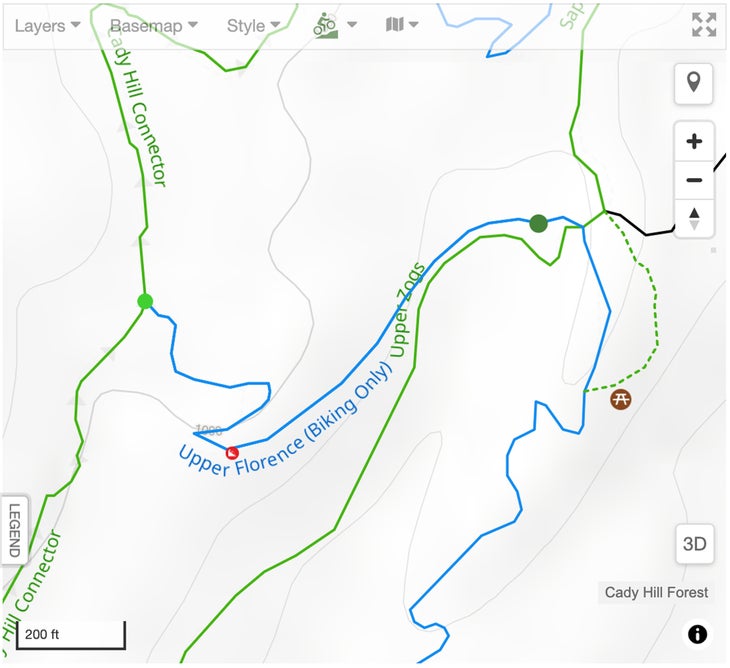
The Adventure: Stop at the Waterbury-Stowe station, which is within walking distance of historic downtown Waterbury, a lovely place to stay the night. Stowe, home of the massive ski resort of the same name, is 10 miles away and reachable by bus or bike. Bring your skis in winter or your bike in summer (if a bike is under 50 pounds, with tires under 2”, you can carry it on, but check bigger bikes at $20 per rig). The Stowe Recreation Path is five miles long, connecting various trail systems and more than 50 miles of singletrack from town. Check out the nearby Cady Hill Forest, and opt for the super flowy Florence Trail.
The Fares: This isn’t an overnight route, so there are no sleeper cars. Choose coach (from $81) or go for business class (from $253), with its increased leg room and free non-alcoholic drinks. Amtrak’s Café has breakfast sandwiches, burgers, salads, and snacks. The food is tasty but pricey. Regular travelers may want to bring your own.
2. The Coast Starlight
The Route: Los Angeles to Seattle
Duration: 1377 miles, 35 hours
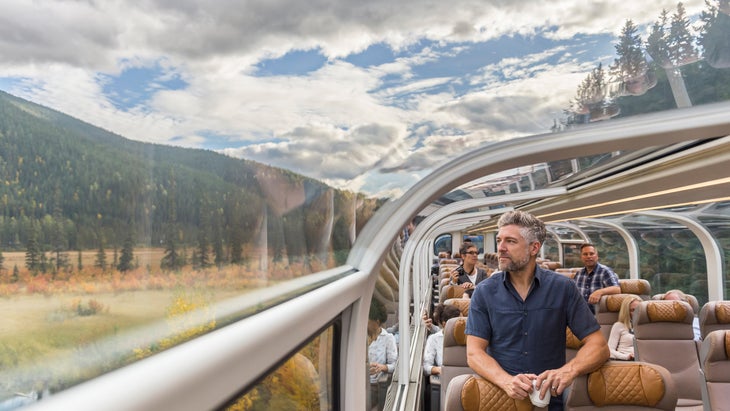
If Amtrak has a superstar route, it’s the Coast Starlight, which runs from Los Angeles to Seattle along the western edge of the United States, hitting Portland, San Francisco, and Santa Barbara. The train runs daily in both directions, with many adventure-prime stops along the way. If you begin in L.A. and travel north, the journey starts among the rocky outcroppings and farms of the San Fernando Valley before hugging the coast with its constant breakers and tall, rocky bluffs. You sleep through Northern California, and the next day gaze out on the dense evergreen forests of the Pacific Northwest and views of the Cascade Mountain Range, including—if you wake up early enough—California’s Mount Shasta, as seen from Oregon.
The Adventure: Just north of Santa Barbara, San Luis Obispo is the first stop after the train leaves L.A. (or, if you’re traveling south, the last stop before L.A.), and an ideal spot for a surf break. (Again, schedule any stops ahead of time). There’s no shortage of rental shops, but you can check your own surfboard on the Coast Starlight for just $10. Pismo Beach, 13 miles west and accessible from the station by an hourly bus, has one of the most consistent breaks on California’s Central Coast. The Pismo Beach Pier attracts the most surfers, and hosts a steady clip of contests, but there are several miles of quieter stretches to explore. Pismo’s sloping beach also means a softer wave—better for beginner surfers—than those at some other California places.
The Fares: You can get coach tickets (from $100) or private sleeper cars (from $674). It’s a one-night trip, so you could save some money by roughing it in a seat just for the night. All passengers may use the observation car, with its glass dome ceiling.
3. The Canadian
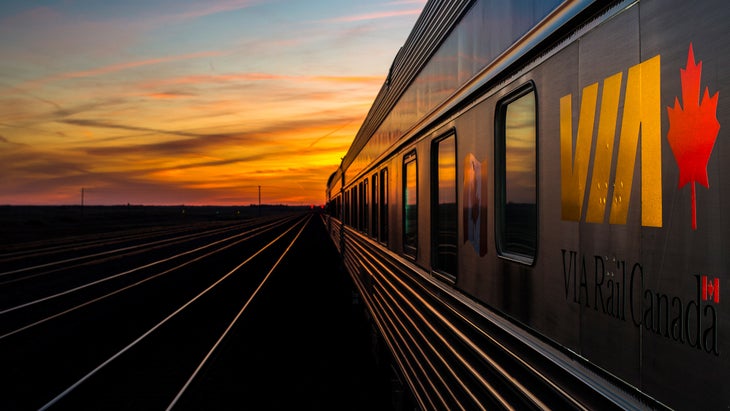
The Route: Toronto to Vancouver
Duration: 2,775 miles, four days, four nights
VIA Rail, Canada’s national rail service, operates a number of incredibly scenic train routes throughout the country (you can take a train to Churchill, the polar-bear capital of the world), but the Canadian is the crown jewel, sampling diverse landscapes from Toronto to Vancouver. The first two days of the trip pass through eastern Canada, known as “the Great Canadian Shield,” a sparsely populated area loaded with thousands of natural lakes and forests full of spruce and pine. East of Winnipeg, the terrain shifts to vast prairie for a day before hitting the jagged, ice-capped peaks of the Canadian Rockies and crossing the Athabasca River amid a dense fir forest. In Jasper National Park, you’ll see the blocky-topped 7,500-foot Roche Miette mountain on the horizon, as well as Mount Yellowhead, Mount Robinson, and Pyramid Falls. Make your way early to one of the glass-dome viewing cars to get a spot.
The train runs twice a week, hitting the towns of Winnipeg, Edmonton, and Jasper. The regularly scheduled stops are short (only a couple of hours at each town), but you can arrange for a multi-day itinerary through VIA Rail.
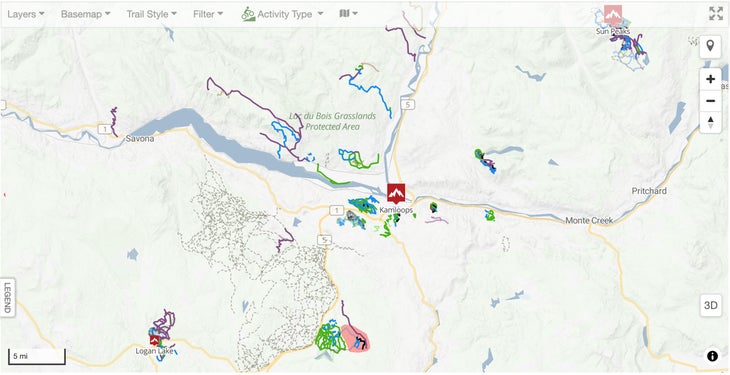
The Adventure: The town of Kamloops sits in the Thompson River Valley, known for its sandstone canyons, rolling hills, and a vast mountain bike system, comprised of both the largest municipal bike park in North America (the Bike Ranch) and lift-served downhill trails at Harper Mountain, a ski and snowboard resort. The trails are fast, flowy, and technical. Start with the Bike Ranch, which has a mix of downhill trails, a massive jump park, and a few intermediate and beginner lines for good measure.
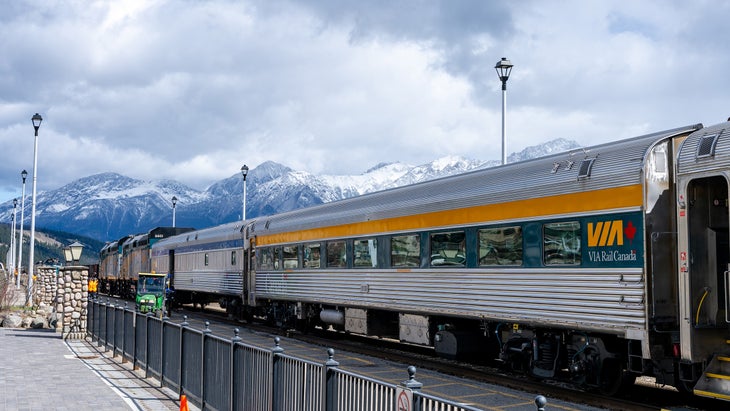
The Fares: Prices for the full trip start at $514 for economy class, but you’ll be sleeping in a reclining seat and eating from a take-out counter. The Sleeper Plus fare (from $1,387) gets you a private cabin, access to the dining car, and community showers. Splurge for the Prestige class (from $6,261) and you get your own shower as well as a concierge, who changes your bedding and helps you with any requests during the trip.
4. The Denali Star
The Route: Anchorage to Fairbanks
Duration: 356 miles, 12 hours
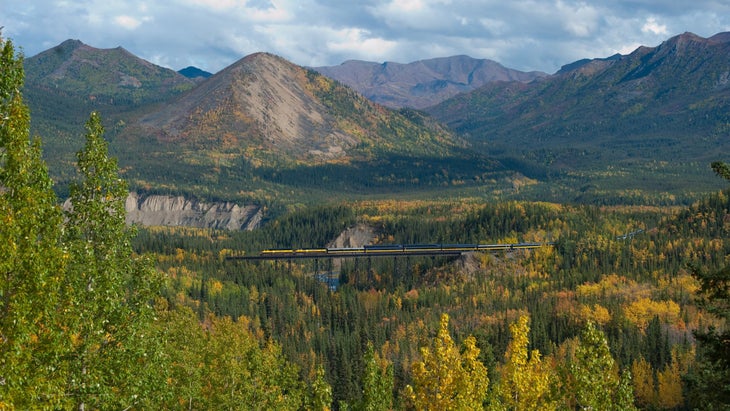
Alaska Railroad operates a handful of train routes throughout the Last Frontier, but the Denali Star is the flagship, running daily during the summer (May 9 to September 19), connecting Alaska’s two biggest cities and hitting Denali National Park along the way. The scenery couldn’t get more Alaskan: the train crosses the Knik River, which forms a broad valley full of alpine meadows that stretch to the bases of glaciers and the Chugach Mountains, then picks up views of Denali above the Susitna River before dipping into the roadless backcountry, where you look out on the Alaska Range and Healy Canyon. The route stops for 30 minutes at Denali National Park and Talkeetna, but if you really want time to explore around the tallest mountain in the U.S., turn this into a multi-day trip with overnights along the way.
The Adventure: Sure, you might want to climb the 20,310-foot mountain for which Denali National Park is named, but that adventure isn’t for everyone, especially on a whim during a train trip. Instead, you can hike up 4,400-foot Sugarloaf Mountain. The Sugarloaf Mountain Trail begins behind the Grande Denali Lodge and ascends 2,700 feet in two miles to the above-tree line summit with views of Mount Fellows and Mount Dora, two peaks in the Alaska Range. You could also sign up for a Discovery Hike, a full-day adventure led by a park ranger. The location changes daily, but a Discovery Hike day is typically eight to ten hours and includes off-trail trekking.
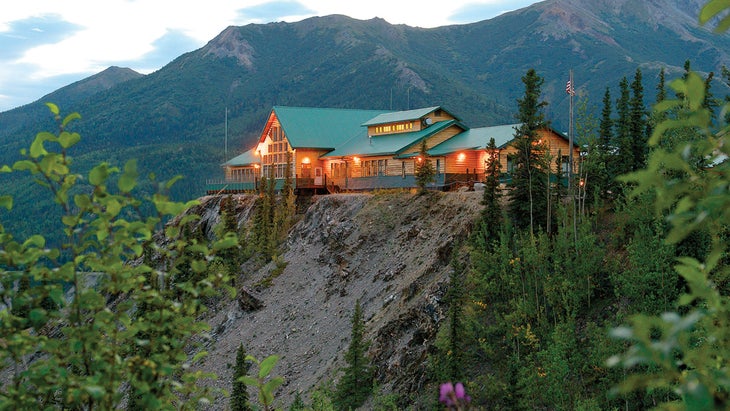
The Fare: Choose from Adventure class (from $215) and Goldstar class (from $432). If you opt for Goldstar, you ride in glass-dome cars and have access to an outdoor viewing platform. The price also includes meals in the dining car and two free cocktails per day.
5. Rocky Mountaineer: Rockies to the Red Rocks
The Route: Denver to Moab
Duration: 375 miles, two days with an overnight in Glenwood Springs
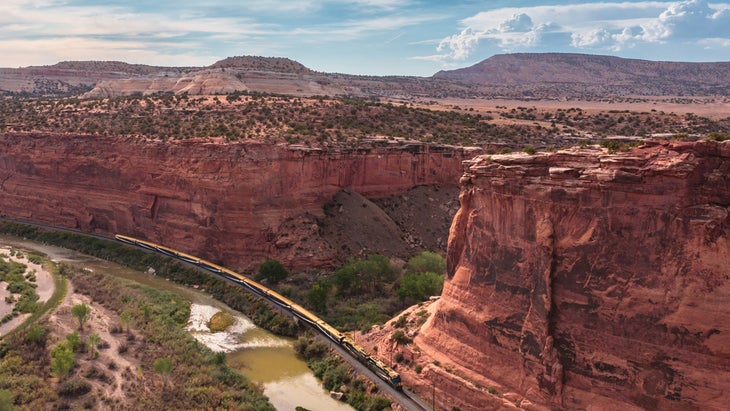
Amtrak isn’t the only company running trains in the U.S. The Rocky Mountaineer, a luxury train service formerly used for scenic routes through the Canadian Rockies, debuted its first U.S.-based trip in 2022. The Rockies to Red Rocks connects Moab with Denver in a two-day journey along the Colorado River, passing remote, roadless canyons only visible from the train. You see the 25-mile-long Ruby Canyon, winding through towering sandstone cliffs on the Utah-Colorado border, and watch the lights flicker off the rock walls in the 6.2-mile Moffat Tunnel as the train cuts through the Continental Divide. The trip takes two days, but instead of offering sleeper cars, the Rockies to Red Rocks puts you in a two- to three-star hotel (the specific hotels change) within walking distance of the Glenwood Springs station. On board, you receive a three-course breakfast and lunch each day.
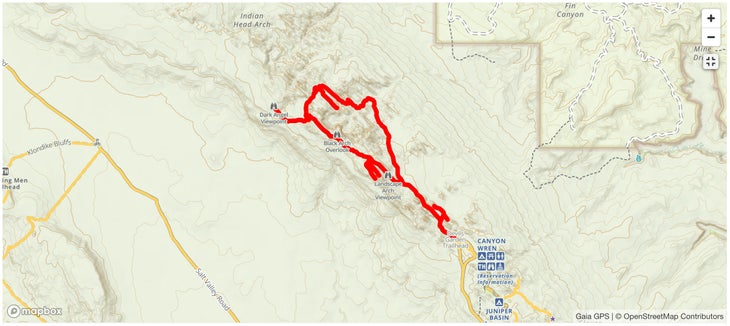
The Adventure: You’re staying over in Glenwood Springs, so soak in one of the town’s developed hot springs; Glenwood Hot Springs Resort has a big lap- and crowd-sized pool kept at 90-93 degrees, and a smaller pool that stays at 104 degrees (day passes start at $32). Iron Mountain Hot Springs has 16 geothermal pools of varying temperatures (passes start at $40). Further, in Moab, Arches National Park is a must. Hike to Landscape Arch, at 306 feet the longest natural arch in the country, on the 7.6-mile Devil’s Garden. This trail is a gem even among great hikes in our national parks.
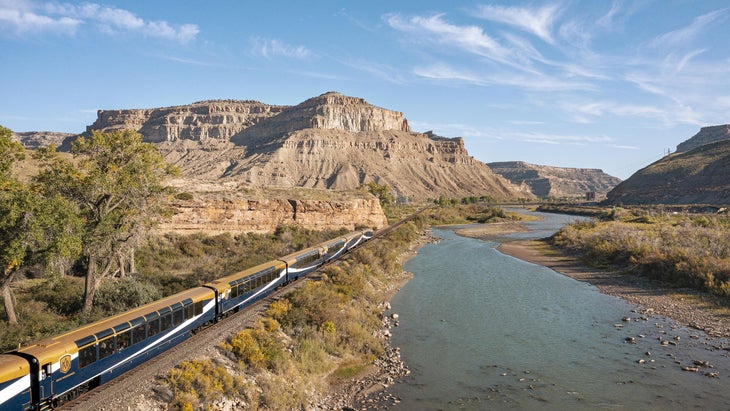
The Fares: Prices start at $1599 per person, and include on-board meals and your hotel room in Glenwood.
6. The Empire Builder
Route: Chicago to Seattle
Duration: 2,206 miles, 48 hours
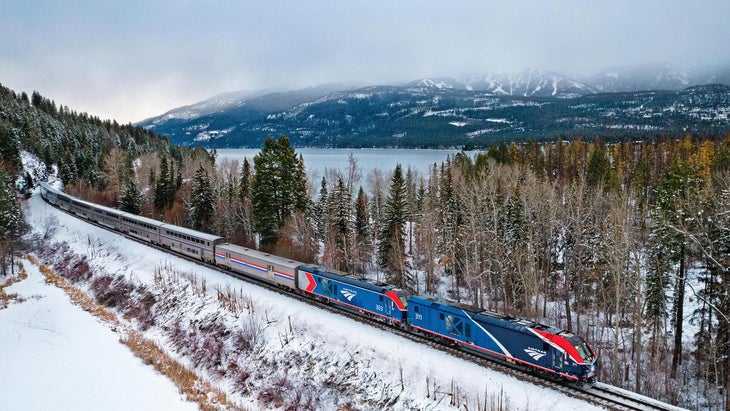
Think two full days on a train is too much? Not when you’re traveling through eight different states, tracing the U.S./Canadian border, and hitting Glacier National Park. The Empire Builder begins with views of Chicago’s skyline, and then crosses the Mississippi River, which is surprisingly wide (several hundred feet) even though you’re close to the headwaters. You’ll see the bright lights of Minneapolis and St. Paul, enter the Great Plains at night, and wake up in North Dakota looking out on pastures of wheat shimmering gold in the sun. Make sure to be in the glass-domed lounge car as you approach Glacier National Park, the train winding along the Flathead River with views of snowfields clinging to the steep granite peaks of the Lewis Ranges. Before the final destination of Seattle, you can detour into Spokane and head south into Oregon and the Columbia River Gorge, where you’ll get views of Mount Hood.
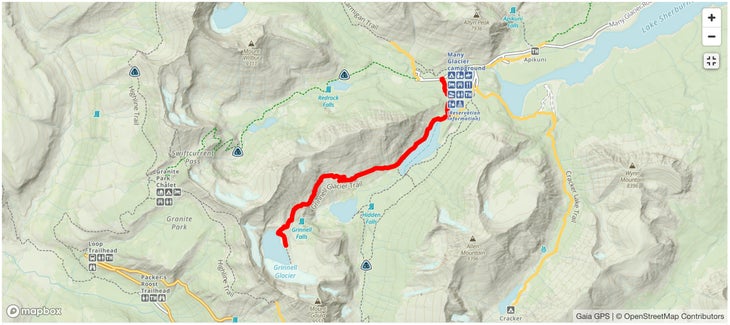
The Adventure: The climax of this trip is Glacier National Park. If you time a spring trip perfectly, you can pedal Going-to-the-Sun Road after it’s plowed but before it opens to vehicles. Whitefish Outfitters offers rental bikes and shuttles to the start of the ride (from $45). Your other best bet is to hike. Check out the 10.6-mile out and back Grinnell Glacier Trail, which passes waterfalls and backcountry lakes before delivering you to the glacier of that name, one of the few in the park you can actually walk across.
The Fares: This train has a number of options. Coach (from $160) will get you a doss in a reclining chair, while First Class fares with private rooms start at $979 and include all meals on board and access to the lounge and communal showers. For $3,405, the First Class Superliner Bedroom Suite includes a full bedroom with its own bathroom. Amtrak also offers a comprehensive, 10-day package deal ($3499 per person) with multiple days in Chicago, Glacier, and Seattle, and activities and lodging planned for you.
Onboard with all of that? Pick your route, plan your stops, and ride the rails to adventure.
Graham Averill is Outside magazine’s national parks columnist. He loves the idea of being able to drink a beer, eat snacks, and play poker while traveling from point A to point B.
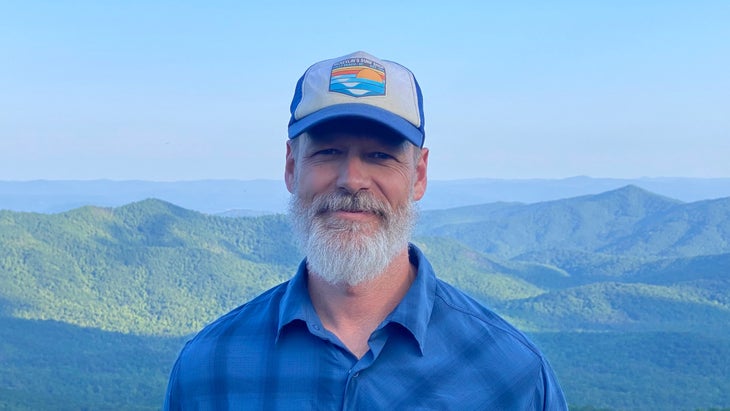
For more by the same author, see:



